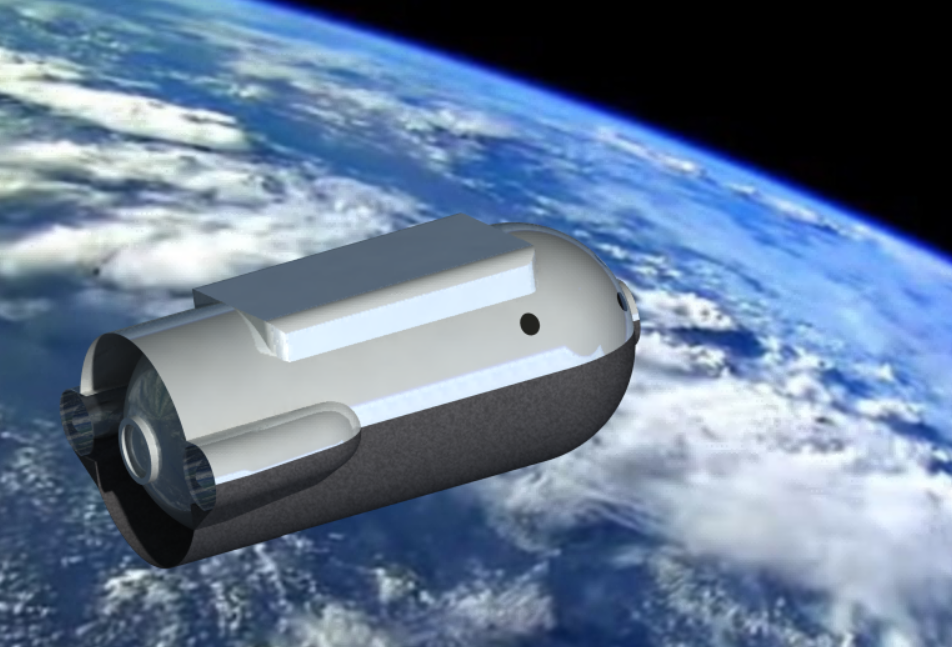The essential element is a shuttle to transport the crew during the various stages of the travel. In this project, the crew of 6 astronauts takes their seats in the multi-purpose manned vehicle (MMV) for each transfer. The MMV is made up of 3 sub-parts:
– The inhabited compartment sized for 6 astronauts in comfort optimized for a week (several months in a crisis).
– The propulsion block, with tanks for 8 tons of hydrolox plus 500 kg of hydrogen recovery intended to inflate lift balloons. The propulsion is made up of two small-diameter engines.
– The recovery system is consisting of a ventral heat shield inspired by the re-entry demonstrator European atmospheric IVX, for a re-entry from a hyperbolic (if necessary with successive air-bratings) and a system of hydrogen lift recovery sized for earth return or Venusian.

| Item | Mass kg |
| Computer Com, Nav | 250 |
| Power | 100 |
| Propulsion Atmospheric | 50 |
| Thermal | 100 |
| ECLS (including closed-circuit water) | 200 |
| Crew | 800 |
| Freight (including food for a week) | 100 |
| Engines[1] | 350 |
| Rcs | 200 |
| Structure Tanks | 1 150 |
| Balloons | 200 |
| Shield | 650 |
| Hydrogen recovery | 500 |
| Reserve Design | 350 |
| Empty mass | 5 000 |
| Propellant | 8 000 |
| Isp (s) | 444 |
| Delta-V (m/s) | 4 166 |
[1] data from these engines are taken from HM7B.
With a Delta-V 4.17 km/s, the MMV can be mounted on a first stage to place itself on its own. in a low Earth orbit. It can also reach a lunar orbit and return, if it is placed with full in a medium orbit, or be used for a launch to Venus as presented here.
A MMV can be launched to Venus in three different ways:
– With the Venusian launch system .
– With only a first stage, the MMV serves as the second stage to be placed in low Earth orbit, be refuelled and then head for Venus. This method involving a transfer of propellants into orbit will not be developed here.
– In payload with ergols, scenario developed below. In this case, the MMV and a cargo module are placed in orbit by an Ariane 6 qualified for flight Lived.
For the calculations, we consider that a contribution of 9300 m/s is needed to place a payload in low orbit. To reach Venus, we add 3700 m/s for a total delta-V of 13,000 m/s.
Both versions of Ariane 6 can be used according to the desired mass for the Cargo.
| Ariane 6.4 | M stage (t) | Initial M (t) | M ergols (t) | Isp (Ns/kg) | Delta-V (m/s) |
| Cargo | 5,15 | ||||
| MMV | 13,0 | 18,15 | 8,00 | 4 355,64 | 2 531,48 |
| 2nd stage | 28,6 | 46,75 | 24,28 | 4 560,00 | 3 340,81 |
| 1st stage | 191,0 | 237,75 | 171,90 | 3 551,00 | 4 558,92 |
| 4 boosters | 520,0 | 757,75 | 481,72 | 2 550,00 | 2 575,10 |
| Delta-V total | 13 006,31 |
| Ariane 6.2 | M stage (t) | Initial M (t) | M ergols (t) | Isp (Ns/kg) | Delta-V (m/s) |
| Cargo | 2,85 | ||||
| MMV | 13,0 | 15,85 | 8,00 | 4 355,64 | 3 060,52 |
| 2nd stage | 28,6 | 44,45 | 24,28 | 4 560,00 | 3 603,17 |
| 1st stage | 191,0 | 235,45 | 171,90 | 3 551,00 | 4 650,64 |
| 2 boosters | 260,0 | 495,45 | 240,86 | 2 550,00 | 1 697,82 |
| Delta-V total | 13 012,15 |
